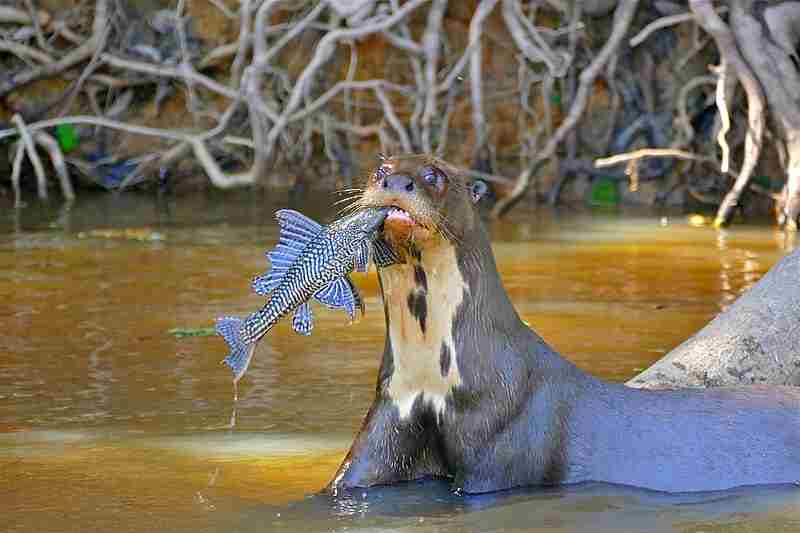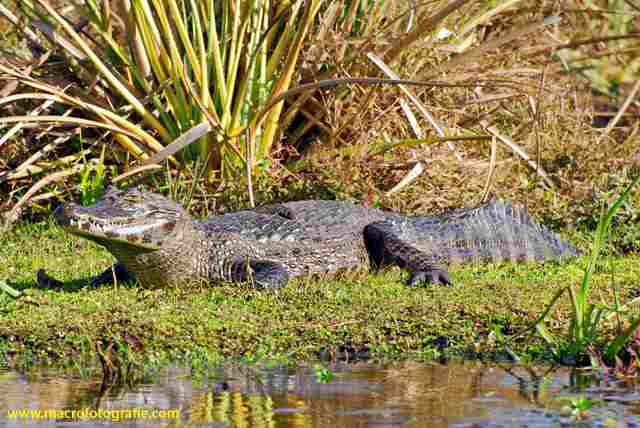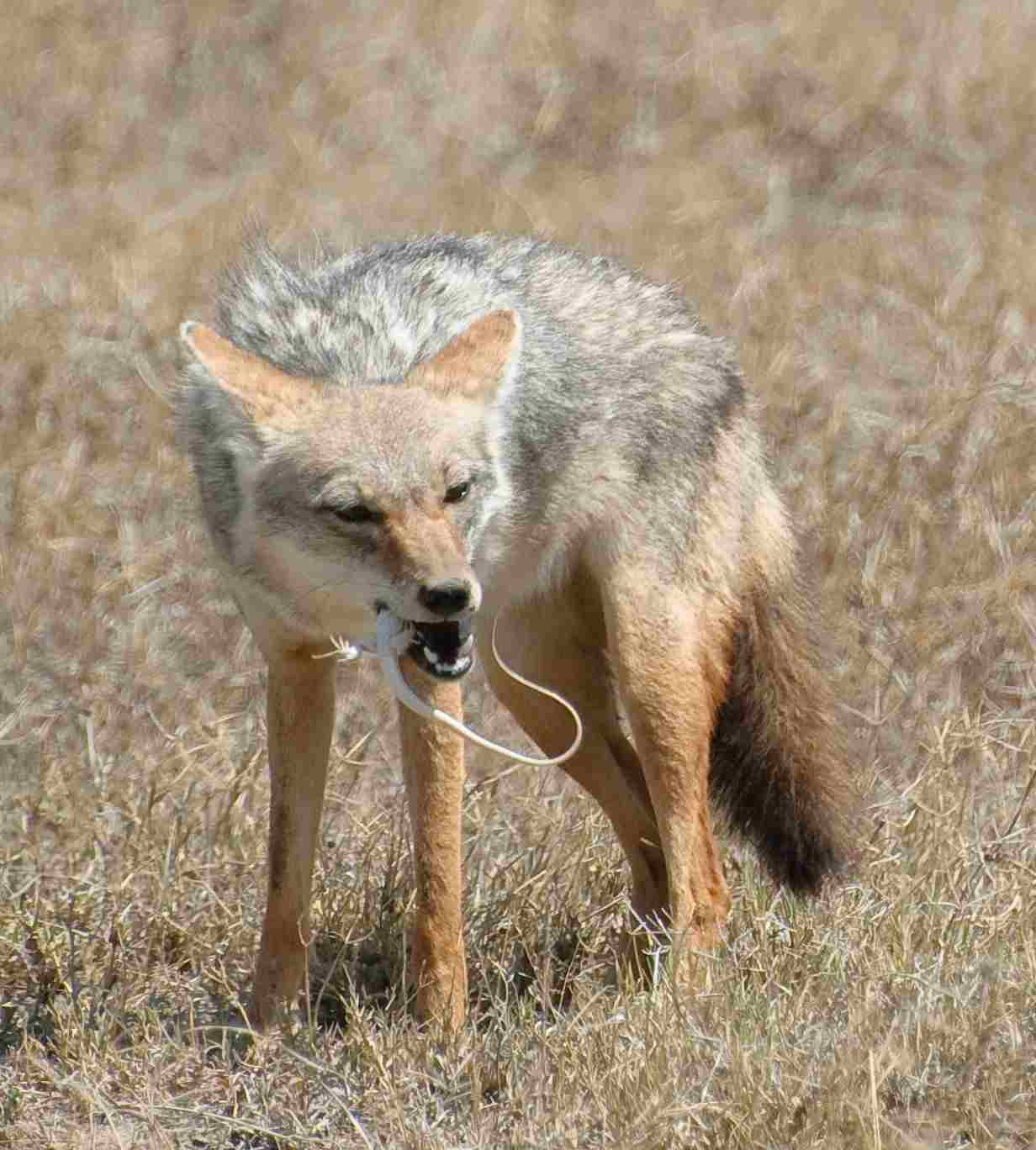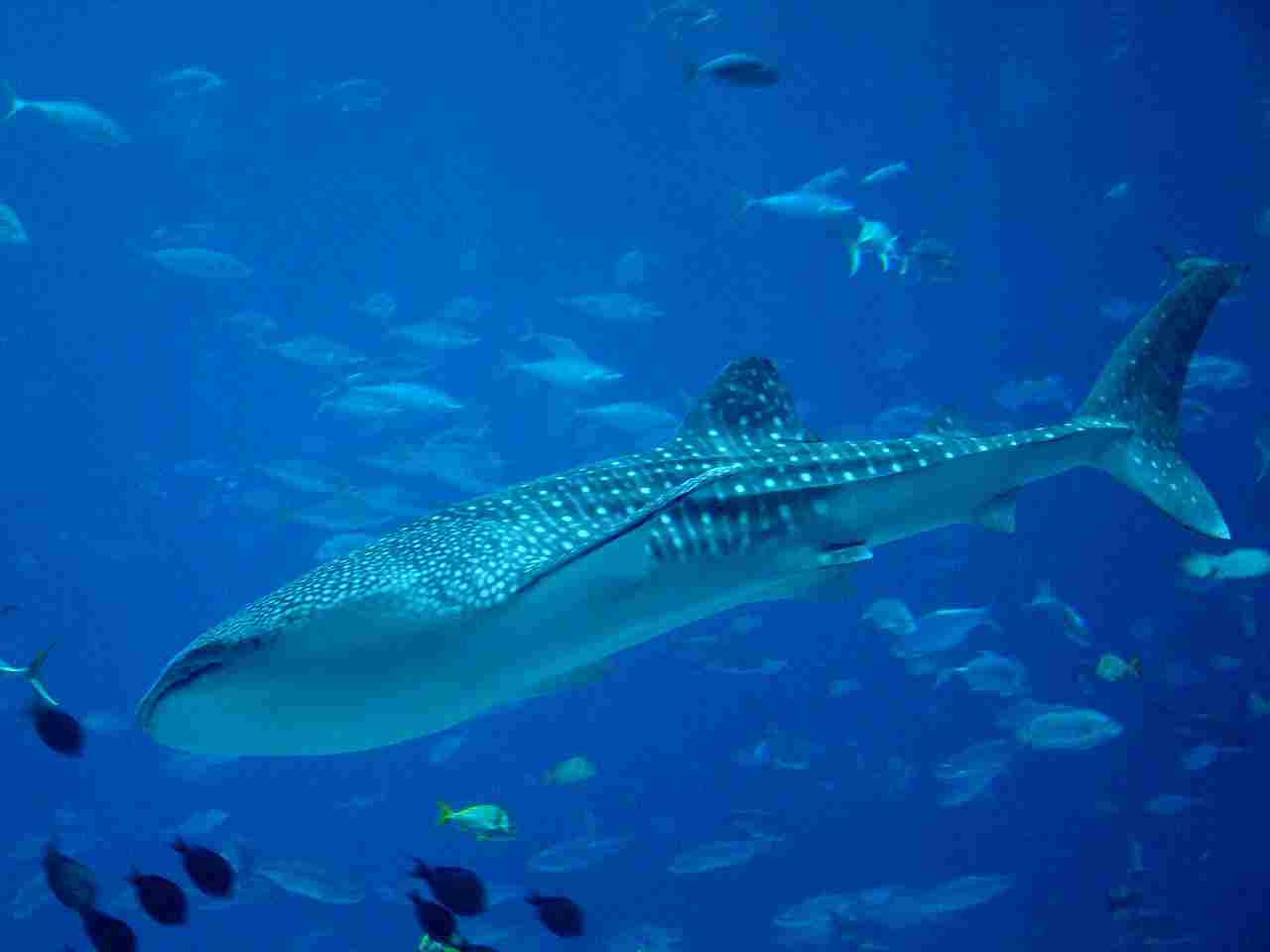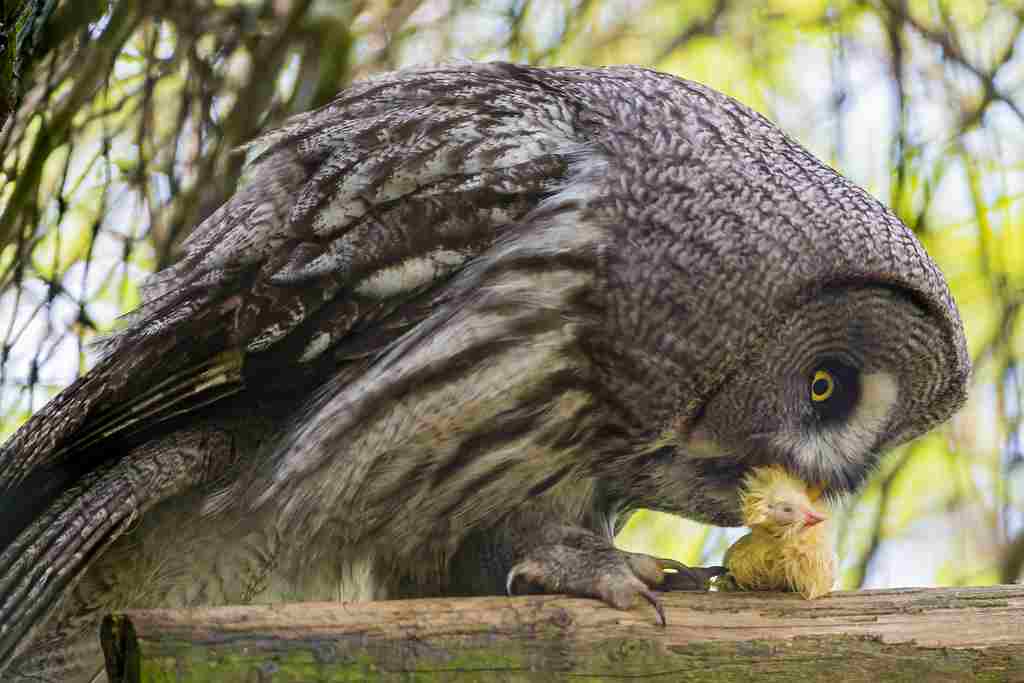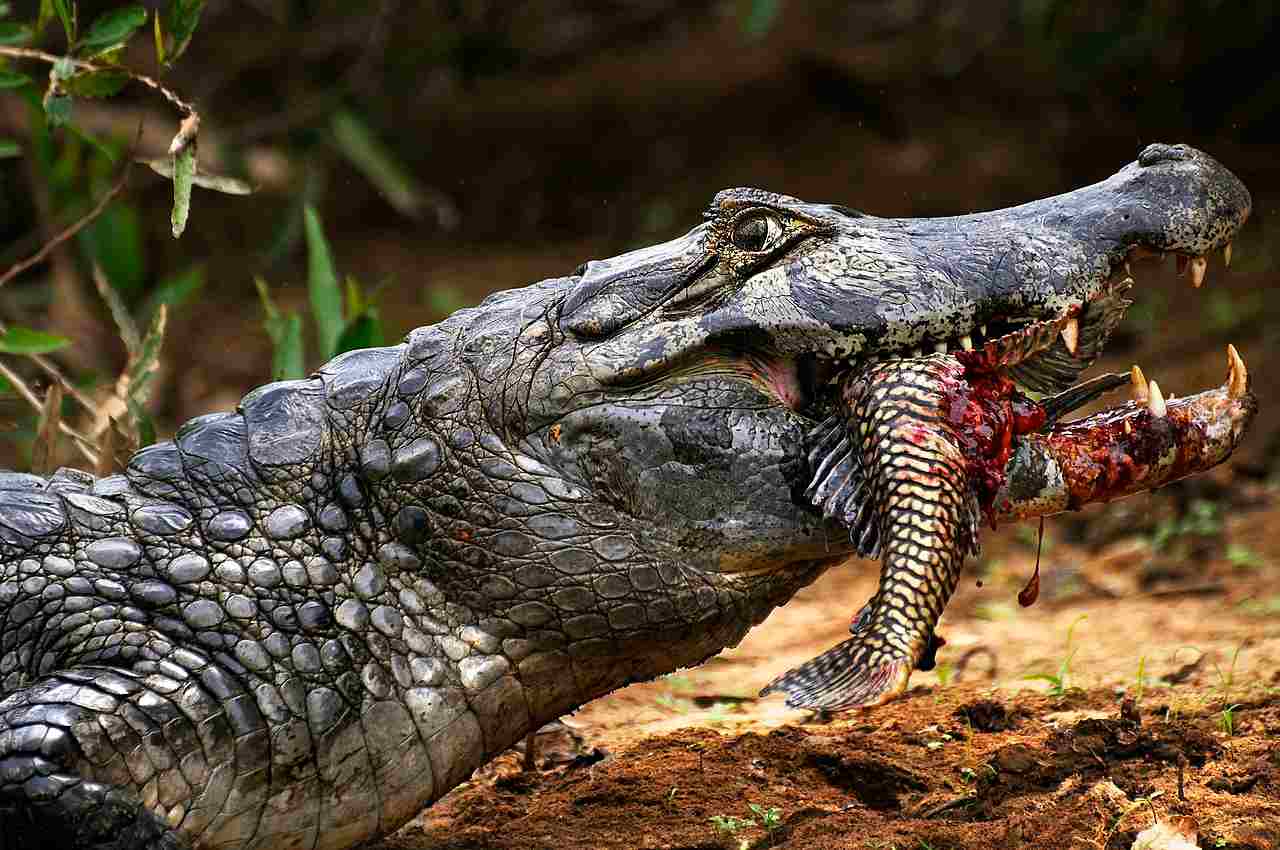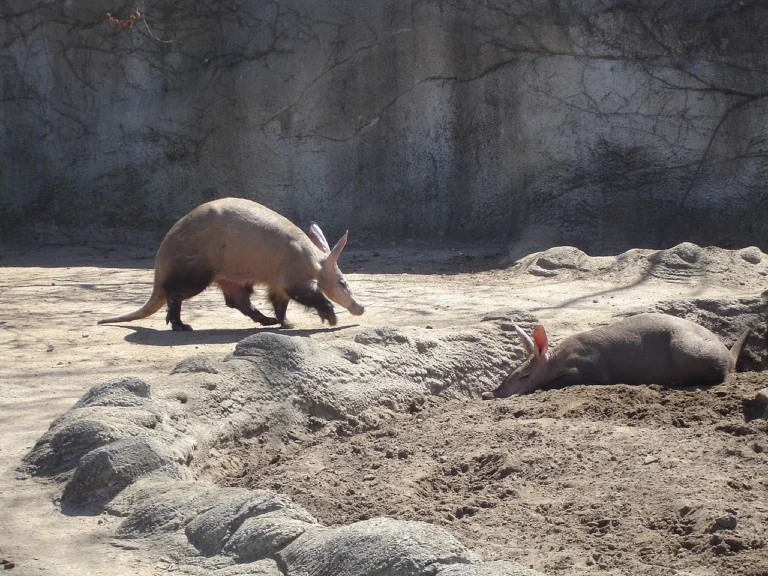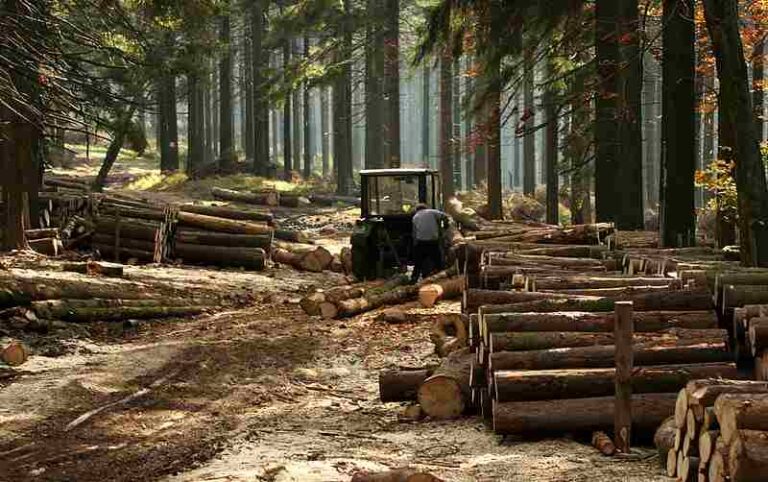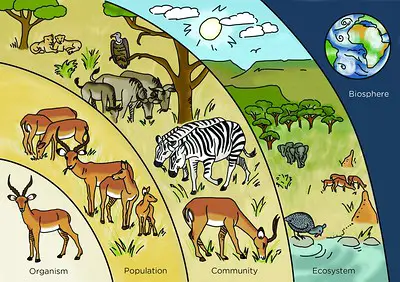Rainforest Food Chain with 5 Trophic Levels and Decomposers
Rainforest food chain comprises of producers like epiphytes; primary consumers like tapir; secondary consumers like spectacled owl; tertiary consumers like caiman; quaternary consumers like jaguar; detrivores like dung beetle; and decomposers like fungi.
This article discusses rainforest food chain with its five trophic levels, components and functions, as follows;
1). Trophic Level 1: Producers in the Rainforest (as part of the Rainforest Food Chain)
Producers in the rainforest are vital in their role, in the ecosystem.
These organisms are responsible for the capture and conversion of solar radiation (in the form of visible light) into biomass, through the process of photosynthesis.
Rainforest producers are mostly vascular and non-vascular plants, and are highly dominated by trees that form the well-known canopy-forest structure.
These plants constitute the basal level, or foundation of the food chain, through their activities that introduce energy into the rainforest to directly or indirectly nourish the diverse array of heterotrophic organisms present.
Examples of Producers in the Rainforest
Examples of producers in the rainforest are; epiphytes, canopy trees, as well as understory and forest-floor plants.
*Rainforest Epiphytes
Epiphytes are a group of plants that have evolved to grow on the trunks and branches of other plants, without being parasitic or harming the supportive plants [9].
They derive water and nutrients from rain and air-borne minerals, as well as debris that accumulates around their points of anchorage. Some epiphytes that occur in rainforests are; bromeliads and orchids.

*Canopy Trees in the Rainforest
Canopy trees are the most dominant producers in forests, and constitute the high-rising, massive rainforest canopy.
Photosynthesis occurs efficiently in these trees, which generally have well-adapted leaves for sunlight capture, and are well exposed to solar rays due to their height.
Examples of canopy trees in the rainforest biome are ebony, iroko, and African mahogany [10].
They create a lifeform-supporting microclimate in the forest by reducing the rate of solar penetration and locking-in moisture. They also create microhabitats for various organisms.
*Understory Plants in the Rainforest
The understory in a rainforest occurs beneath the canopy layer, and comprises of smaller plants that have evolved to thrive in a shaded environment with relatively-low exposure to sunlight.
Some examples of understory rainforest plants are; shrubs, ferns, and mosses. They contribute to species richness/diversity in the rainforest, facilitate the creation of microclimates and microhabitats; and serve as a food source to several animals.
*Forest-Floor Plants
Also known as 'ground plants', the forest-floor plants occur at the lowest level in the vertical, vegetative profile of a rainforest.
They include various species of herbaceous plants, mosses, and ferns; and thrive under the humid, shaded conditions of their habitat; from which they play an important role in the production and recycling of both biomass and nutrients.

*Producers in the African Rainforest
The African rainforest is most notable in the central region of the continent, and spans multiple countries including the Republic of Congo, Cameroon, Gabon, and Democratic Republic of Congo.
Characteristics of the African rainforest include a multi-layered, dense vegetative structure consisting of shrubs; ferns, herbs; epiphytic plants, and trees.
Examples of producers in the African rainforest are; African oil palm (Elaeis guineensis), African mahogany (Khaya spp.), Raffia palm (Raffia spp.) and African walnut (Lovoa trichilioides).
These trees are crucial in their ecologic role within the biome, as well as for their economic value as a source of timber. The latter has been behind several cases of severe deforestation and degradation of rainforests in the region.
2). Trophic Level 2: Primary Consumers in the Rainforest
Primary consumers in the rainforest have a vital role to play toward the sustainability of energy-transfer in the food chain.
These consumers are mostly herbivorous animals which feed directly on plants (that is; the producers).
By consuming plant parts like fruits, flowers, leaves and seeds; they obtain nutrients and energy for their survival. They also serve as a nutritional bridge between producers and higher consumers that cannot directly feed on plant matter; by serving as food sources for these higher consumers.
Examples of Primary Consumers in the Rainforest
Examples of primary consumers in the rainforest are; howler monkey, leafcutter ant, capybara, sloth, toucan, tapir, agouti, macaw, and fruit bat.
*Howler Monkey as a Rainforest Primary Consumer
The howler monkey is a large; arboreal primate that inhabits rainforests of South and Central America [7].
Its diet consists primarily of fruits, flowers, shoots, and leaves from various tree species.
*Leafcutter Ant
Leafcutter ant occurs in several rainforest zones, including Central Africa.
Their adaptive behaviors include stripping and carrying leafs to their colonies where these leaves are used for the cultivation of a fungus which is their primary source of food [12].
*Capybara as a Primary Consumer in the Rainforest
Capybara is considered the world's largest rodent [6], and can be found in rainforests of South America.
It is a semi-aquatic mammal that feeds mainly in aquatic vegetation, tree bark, and grasses.

*Sloth as a Rainforest Primary Consumer
The sloth is a mammal known for its sluggish mobility, which inhabits South and Central American rainforests.
It is a primary consumer that depends on a diet of leaves from trees like the Cecropia.
Sloths are excellent at energy conservation, having a slow metabolic rate and spend much of their time hanging in trees and grazing on leaves.
*Toucan
The toucan is a colorful bird which occurs in Central and South American rainforests.
Their diet is varied and consists of insects, berries, fruits and seeds.
Although this indicates an omnivorous feeding habit, a significant portion of toucans' food is made up of plant matter, so that they function in full capacity as primary consumers.
Toucans contribute to seed dispersal through their feeding and excretion (of seeds).
*Agouti as a Rainforest Primary Consumer
Agouti is a small rodent found in South and Central American rainforests, which is known as a seed disperser, and a herbivorous feeder.
The diet of this rodent consists of nuts and felled fruits; and they have the habit of caching food through shallow burial (of the food materials) for later consumption [3]. Some of the buried plant matter may contain seeds and other parts that cause the growth of new plants and contribute to the regeneration of forest vegetation.
*Macaw
Macaw is a large, vibrant parrot that occurs in rainforests of South and Central America.
Its food includes a wide variety of flowers, nuts, seeds and fruits.
Like rodents, the macaw contributes to seed dispersal through their feeding and excretory activities.
*Fruit Bat as a Rainforest Primary Consumer
The fruit bat or flying fox is a geographically-versatile rainforest mammal, that feeds on pollen, fruits and nectar.
It plays an effective role in pollination within its environment [5], as well as in the dispersal of seeds.
*Tapir
Tapir is a large mammal with herbivorous feeding habits, that is found in South and Central American rainforests, and also occurs in forests in Southeast Asia.
Its herbivorous diet is diverse, and includes twigs; aquatic plants, and leaves. The tapir contributes to seed dispersal through its activities.

Primary Consumers in the African Rainforest
Primary consumers in the African rainforest include;
1. Duiker
2. Bushbuck
3. Chimpanzee
4. Gorilla
5. Toucan
3). Trophic Level 3: Secondary Consumers in the Rainforest (as part of the Rainforest Food Chain)
Secondary consumers in the rainforest are a group of carnivorous and omnivorous animals that derive energy and nutrients by feeding on primary consumers, or on other secondary consumers.
They occupy the third trophic level of the food chain/energy pyramid, and are important for their role in influencing the dynamics of prey populations and facilitating the flow of energy. They also contribute to overall diversity and stability of their habitat.
Examples of secondary consumers in the rainforest are owls, lizards, vipers and spider monkeys.
*Owl as a Rainforest Secondary Consumer
Various species of owls including the spectacled owl (Pulsatrix perspicillata) and Madagascar scops owl (Otus rutilus), are found in rainforests around the world.
Owls are secondary consumers because they are less-powerful than larger tropical raptors such as the harpy eagle; and prey mostly on small primary consumers.
Food for the owl consists of rodents, reptiles, and amphibians, among other animals.
*Spider Monkey as a Rainforest Secondary Consumer
The spider monkey is an arboreal primate found in South and Central American rainforests, which include the Amazon forest [11].
It is an omnivore, and feeds mainly on seeds, leaves, nuts and fruits; which it supplements with animal food sources like arachnids, insects, and other invertebrates.
4). Trophic Level 4: Tertiary Consumers in the Rainforest
Tertiary consumers in the rainforest are carnivorous (and few omnivorous) animals that are often classified as apex predators at the highest level of the ecosystem.
They are only displaced from this position when quaternary consumers are present, as in this case.
Rainforest tertiary consumers prey on secondary and primary consumers. Their feeding activities have significant influence on the population size and adaptation of their prey.
Examples of Tertiary Consumers in the Rainforest
Examples of tertiary consumers in the rainforest are; South American bushmaster, caiman, Amazon River dolphin, and giant otter.
*South American Bushmaster as a Rainforest Tertiary Consumer
The South American bushmaster is a venomous snake that primarily inhabits rainforests in South America.
It is a tertiary consumer that preys on lizards, small mammals, birds, and other snakes on the forest floor.
*Caiman
Spectacled caiman and black caiman are examples of caiman crocodiles found in aquatic microhabitats within the rainforest [8].
Their diet includes fish, smaller reptiles, mammals, and birds that come within reach in their microhabitat.
*Amazon River Dolphin as a Rainforest Secondary Consumer
The Amazon River dolphin (also called the Pink River dolphin) an aquatic mammal that can be found in rivers within the Amazon rainforest.
It is a tertiary consumer in its microhabitat, because it preys on other aquatic animals, including relatively-small and medium-sized carnivorous fish.
*Giant Otter
In the Amazon rainforest, giant otters function as tertiary consumers, that feed on various smaller animals in terrestrial and aquatic zones, including catfish, carnivorous piranhas, and other tertiary consumers like caiman.

Tertiary Consumers in the Amazon Rainforest
Tertiary consumers in the Amazon rainforest include;
1. Amazon River dolphin
2. Caiman
3. Giant otter
5). Trophic Level 5: Quaternary Consumers in the Rainforest (as part of the Rainforest Food Chain)
Quaternary consumers in the tropical rainforest occupy the ultimate apex trophic level (5) of the food chain.
These animals are predatory and biologically-equipped so that they are at a greater advantage than other consumers in their habitat; and can prey on these consumers.
Their role in the rainforest is critical, and involves regulating the populations of organisms in lower trophic levels, and completing the cycle of energy transfer, to ensure continuity of resource-cycling.
Examples of Quaternary Consumers in the Rainforest
Examples of quaternary consumers in the rainforest are; harpy eagle, jaguar, boa constrictor, and green anaconda.
*Harpy Eagle as a Rainforest Apex Predator
The harpy eagle is a large raptor that inhabits rainforest canopies in South and Central America.
It is an iconic bird of prey in the Amazon rainforest [1], and is classified as an apex predator due to its superior size and power compared to other raptors in its habitat.
Harpy eagles prey on a wide variety of animals, ranging from small reptiles and rodents to sloths and monkeys.
*Jaguar
Jaguars are large and powerful felines found in rainforests of South and Central America.
They are iconic apex predators in this zone, and known to prey on caimans, fish, tapirs, deer, capybaras, birds, and peccaries.
*Boa Constrictor as a Quaternary Consumer in the Rainforest
The boa constrictor is a non-venomous, large snake that occurs in the Amazon rainforest, among other forested regions.
It captures prey by ambush and suffocation, and is considered a quaternary consumer within its territory because its hunting strategy enables it exploit a wide range of reptilian and mammalian food sources.

Green anacondas function similar to boa constrictors, and capture prey by ambush and constriction.
They are quaternary consumers within their territory, preying on various animals that include caimans, birds, deer and capybaras.
6). Decomposers in the Rainforest
Decomposers in the rainforest are crucial in their role toward the breakdown of organic matter, like animal waste, and dead plant/animal remains.
Their activities facilitate the recycling of nutrients in rainforests because broken-down biomass releases nutrients back to the soil.
This is essential for the sustainability and growth of the rainforest ecosystem.
Examples of Decomposers and Detrivores in the Tropical Rainforest
Detrivores are non-microscopic organisms that feed on organic detritus like plant litter, and support the decomposers in their role of nutrient cycling.
Examples of decomposers and detrivores in the rainforest are; bacteria, fungi, ants, termites, dung beetles and millipedes.
*Bacteria and Fungi as Decomposers in the Rainforest
Bacteria and fungi are the main microscopic decomposers in rainforest ecosystems.
They breakdown organic matter by secreting enzymes that facilitate biochemical disintegration of complex organic molecules to release bioenergy and nutrients.
*Ants as Detrivores in the Rainforest
Many rainforest are detrivores that feed by scavenging on organic remains and waste from other insects as well as vertebrates.
Their activities help in the decomposition of such materials.
*Termites
Termite populations in the rainforest are fairly large.
Like ants, they are scavenging detrivores, and can be found feeding on plant matter like leaf and wood litter [2].
Using digestive enzymes, they cause such matter to breakdown in the process, and contribute to ecological cycling of nutrients.
*Dung Beetles as Detrivores in the Rainforest Ecosystem
Dung beetles are another group of important detrivorous decomposers, in the rainforest.
They are particularly active in areas occupied or traversed frequently by large herbivores [4] like monkeys and tapirs; which are also the locations where these animals deposit their solid waste.
In the process of extracting nutrients from such waste, dung beetles speed up the process of decomposition and resource-recycling.
*Millipedes in the Rainforest Ecosystem
Millipedes are myriapods and detrivorous feeders.
In the rainforest they feed on leaf litter, decaying animal remains; and other forms of organic debris within their reach (which is mostly on the forest floor).
Their adaptations include specialized mouthparts for chewing and grinding plant matter; and their activities also facilitate decomposition and nutrient-cycling.

Conclusion
The rainforest food chain comprises of;
1. Producers (Trophic Level 1)
2. Primary Consumers (Trophic Level 2)
3. Secondary Consumers (Trophic Level 3)
4. Tertiary Consumers (Trophic Level 4)
5. Quaternary Consumers (Trophic Level 5)
6. Decomposers
These trophic levels are occupied by various groups of organisms ranging from autotrophs to herbivorous, carnivorous and omnivorous heterotrophs.
They differ in their individual functions, but work together to sustain the flow of energy in the rainforest; which is essential for the survival of species.
References
1). Aguiar-Silva, F. H.; Sanaiotti, T. M.; Luz, B. B. (2014). "Food Habits of the Harpy Eagle, a Top Predator from the Amazonian Rainforest Canopy." Journal of Raptor Research 48(1):24-35. Available at: https://doi.org/10.3356/JRR-13-00017.1. (Accessed 30 June 2023).
2). Ashton, L. A.; Griffiths, H. M.; Parr, C. L.; Evans, T. A.; Didham, R. K.; Hasan, F.; Teh, Y. A.; Tin, H. S.; Vairappan, C. S.; Eggleton, P. (2019). "Termites mitigate the effects of drought in tropical rainforest." Science. 2019 Jan 11;363(6423):174-177. Available at: https://doi.org/10.1126/science.aau9565. (Accessed 30 June 2023).
3). Asquith, N.; Terborgh, J.; Arnold, A. E.; Riveros, C. M. (1999). "The fruits the agouti ate: Hymenaea courbaril seed fate when its disperser is absent." Journal of Tropical Ecology 15(02):229 - 235. Available at: https://doi.org/10.1017/S0266467499000772. (Accessed 30 June 2023).
4). Buse, J.; Hoenselaar, G.; Langenbach, F.; Schleicher, P.; Twietmeyer, S.; Popa, F.; Heurich, M. (2021). "Dung beetle richness is positively affected by the density of wild ungulate populations in forests." Springer, Biodiversity and Conservation 30(6). Available at: https://doi.org/10.1007/s10531-021-02238-z. (Accessed 29 June 2023).
5). Camelle, J. D.; Bacordo; Ruffa, M. M.; Marfil, J.; Aries, G.; Tabora, J. A. G. (2019). "Fruit bats as natural foragers and potential pollinators in fruit orchard: a reproductive phenological study." Available at: https://agris.fao.org/search/fr/records/6474810f425ec3c088f8de0e. (Accessed 29 June 2023).
6). Herrera-Álvarez, S.; Karlsson, E.; Ryder, O. A.; Lindblad-Toh, K.; Crawford, A. J. (2021). "How to Make a Rodent Giant: Genomic Basis and Tradeoffs of Gigantism in the Capybara, the World's Largest Rodent." Mol Biol Evol. 2021 May 4;38(5):1715-1730. Available at: https://doi.org/10.1093/molbev/msaa285. (Accessed 29 June 2023).
7). Horwich; R.; Johnson, E. D. (1986). "Geographical distribution of black howler (Alouatta pigra) in Central America." Primates 27(1):53-62. Available at: https://doi.org/10.1007/BF02382522. (Accessed 29 June 2023).
8). Laverty, T. M.; Dobson, A. P. (2013). "Dietary overlap between Black Caimans and Spectacled Caimans in the Peruvian Amazon." Herpetologica 69(1):91-101. Available at: https://doi.org/10.1655/herpetologica-d-12-00031. (Accessed 30 June 2023).
9). Nieder, J.; Prosperi, J.; Michaloud, G. (2001). "Epiphytes and their contribution to canopy diversity." Plant Ecology 153(1):51-63. Available at: https://doi.org/10.1023/A:1017517119305. (Accessed 29 June 2023).
10). Olajuyigbe, S.; Adaja, A. A. (2016). "Floristic composition, tree canopy structure and regeneration in a degraded tropical humid rainforest in southwest Nigeria." Available at: https://www.ajol.info/index.php/tjfnc/article/view/132042. (Accessed 29 June 2023).
11). Rabelo, R.; Gonçalves, J. R.; Silva, F. E.; da Rocha, D. G.; Canale, G.; Bernado, C. S. S.; Boubli, J. P. (2018). "Predicted distribution and habitat loss for the Endangered black-faced black spider monkey Ateles chamek in the Amazon " Oryx. Available at: https://doi.org/10.1017/S0030605318000522. (Accessed 30 June 2023).
12). Somera, A. F.; Lima, A. M.; Dos Santos-Neto, A. J.; Lancas, F. M.; Bacci, M. Jr. (2015)."Leaf-cutter ant fungus gardens are biphasic mixed microbial bioreactors that convert plant biomass to polyols with biotechnological applications." Appl Environ Microbiol. 2015 Jul;81(13):4525-35. Available at: https://doi.org/10.1128/AEM.00046-15. (Accessed 29 June 2023).
